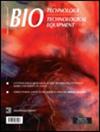Cost-effectiveness of velmanase alfa vs. bone marrow transplantation or no causal therapy in patients with mild to moderate alpha-mannosidosis
IF 1.4
4区 生物学
Q4 BIOTECHNOLOGY & APPLIED MICROBIOLOGY
引用次数: 0
Abstract
Alpha-mannosidosis is an inherited rare disorder of mannose-containing oligosaccharides metabolism that is currently treated by enzyme replacement therapy (ERT), bone marrow transplantation (BMT), or supportive therapy (ST). However, the relative cost-effectiveness of these treatment options is yet unknown. Our study aimed to compare the cost-effectiveness of the treatment options for mild to moderate alpha-mannosidosis. The study is based on a modeling approach using a Discrete-Event Simulation model to generate and simulate the course of the disease under the influence of each of the treatment options: ERT, BMT, and ST. The model had a lifetime horizon and was made from the perspective of the Serbian Health Insurance Fund. Currently, available causal therapy of mild to moderate alpha-mannosidosis with velmanase alpha enzyme replacement is not cost-effective compared with supportive therapy (ICER = 941,587,152 RSD) or bone marrow transplantation (ICER = −398,412,755 RSD). Bone marrow transplantation can be cost-effective compared to supportive therapy (ICER = 6,032,689 RSD), but only if the willingness-to-pay threshold is increased to 9 gross domestic products (GDP) per capita per QALY gained. According to the current threshold, velmanase-alfa is not cost-effective compared to BMT or ST. To make alfa-mannosidosis therapy widely accessible to patients, criteria for assessing the cost-effectiveness of orphan drugs must include not only the absolute value of ICER but other aspects like equity weightings of QALYs, risk-sharing, reimbursement of severe forms of a disease only, or availability of dedicated funding.velmanase与骨髓移植或无因果治疗在轻度至中度α -甘露甘露病患者中的成本-效果
α -甘露糖病是一种遗传性的罕见的含甘露糖低聚糖代谢疾病,目前通过酶替代疗法(ERT)、骨髓移植(BMT)或支持疗法(ST)治疗。然而,这些治疗方案的相对成本效益尚不清楚。我们的研究旨在比较轻度到中度α -甘露酸菌病的治疗方案的成本效益。该研究基于一种建模方法,使用离散事件模拟模型来生成和模拟每种治疗方案(ERT、BMT和st)影响下的疾病过程。该模型具有终身视界,并从塞尔维亚健康保险基金的角度制作。目前,与支持治疗(ICER = 941,587,152 RSD)或骨髓移植(ICER = - 398,412,755 RSD)相比,使用velmanase α酶替代的轻中度α -甘露甘露病的现有因果治疗并不具有成本效益。与支持疗法相比,骨髓移植具有成本效益(ICER = 6,032,689 RSD),但前提是支付意愿阈值提高到人均国内生产总值(GDP)的9倍。根据目前的阈值,与BMT或st相比,velmanase-alfa不具有成本效益,为了使患者广泛获得α -甘露甘露病治疗,评估孤儿药成本效益的标准不仅必须包括ICER的绝对值,还必须包括其他方面,如QALYs的公平权重、风险分担、仅对严重疾病形式的报销,或专用资金的可获得性。
本文章由计算机程序翻译,如有差异,请以英文原文为准。
求助全文
约1分钟内获得全文
求助全文
来源期刊

Biotechnology & Biotechnological Equipment
工程技术-生物工程与应用微生物
CiteScore
3.10
自引率
0.00%
发文量
90
审稿时长
1 months
期刊介绍:
Biotechnology & Biotechnological Equipment (B&BE) is an international open access journal publishing cutting-edge research. A modern world requires modern biotechnology and nanobiology. The journal is a forum that provides society with valuable information for a healthy and better life and promotes “the Science and Culture of Nature”.
The journal publishes original research and reviews with a multidisciplinary perspective; expanded case reports with a focus on molecular medical research and advanced practice in evidence-based medicine are also considered.
 求助内容:
求助内容: 应助结果提醒方式:
应助结果提醒方式:


